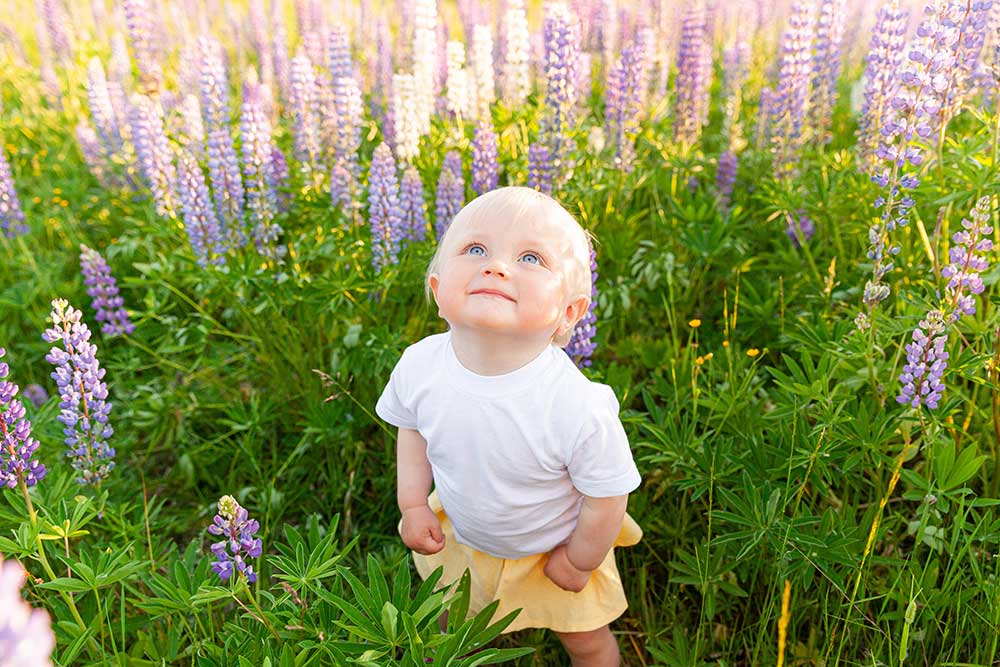The Effects of Climate Change on Children’s Health

The AAP and EPA warn of increased asthma, elevated risk of overheating and dehydration, more premature births, and higher incidents of Lyme disease, to name a few.
Content Warning: This article mentions distressing themes such as death, suicide, miscarriage, and stillbirth.
What was a compelling theory 50 years ago is now an undeniable fact: the earth’s temperature is rising. While there are still some measures we can take to slow climate change for a brighter future, we’re already beginning to experience some of the consequences of our inaction that we’ve been forewarned of. It’s not only natural disasters we have to worry about, either; experts are sounding alarms, trying to warn us of the dangers climate change will have on our children’s health.
On April 25, the United States Environmental Protection Agency (EPA) released a report detailing some of these implications. The same day, the American Academy of Pediatrics (AAP) shared the EPA’s findings on its own website, showing support for the research and advocating for policy change and action. In the article, Mark Del Monte, JD, the AAP’s CEO and executive vice president, was quoted as saying, “For more than 20 years, the AAP has been calling for aggressive policies to halt climate change. Today’s EPA report is another urgent and clear message that we must prevent this harm to children’s health.”
Having these two prominent organizations speak out on climate change and its effects on children’s health is very telling of the bleak outlook detailed in the EPA’s report. From low birth weight to an increase in respiratory illness to hyperthermia-related emergency room visits, whether or not the earth’s rising temperatures will affect our kids is no longer a question.
Heat
No, it’s not just in your head—heat waves are becoming more and more prevalent and problematic every year. Extreme heat is more than just uncomfortable, too; it’s also very dangerous for babies and children.
The EPA’s report details how a child’s body isn’t as efficient as an adult’s at regulating temperature, and this is particularly true for infants and younger children. As a result, children are at a higher risk of overheating, which can lead to fainting, muscle breakdown, organ failure, seizure, coma, or even death. Extreme heat can also cause trouble in school, as it’s linked to poor cognitive function and can negatively impact a child’s ability to concentrate or learn. Playing outdoors in hot weather also increases the risk of dehydration, and tragically, babies and children who are left in hot vehicles will have an even lower chance of survival.
Extreme heat can indirectly affect other areas of health as well, according to the EPA. For instance, a child in a home without air conditioning may get poor-quality sleep, leading to struggling in school and lower grades. Similarly, children in daycares or schools without air conditioning might struggle academically. Hot temperatures have also been linked to depression, anger, and even suicide in adolescents.
Heat waves also pose a risk to pregnant people, as they’re more likely to become dehydrated or experience heat stroke. The EPA’s report says exposing a baby to extreme heat in utero can result in long-term cognitive implications. Finally, heat waves have been linked to preterm labor, which can cause low birth weight and developmental effects.
Infectious Disease
Remember when the Zika and West Nile viruses were a major concern? Get ready to relive these experiences, as well as new ones, as climate change continues to worsen. According to the EPA’s report, “temperature and precipitation levels affect the habitat, range, and density of pathogens, vectors, and hosts,” which means as we experience the effects of climate change, “the geographic extent and concentrations of organisms that spread disease will change, including mosquitos and ticks.”
One illness that we can expect to see an increase in is Rocky Mountain spotted fever, a disease carried by several species of ticks that can cause serious health effects—including death. Similarly, the EPA anticipates more cases of Lyme disease as a result of climate change. Lyme disease is carried by blacklegged ticks (also known as deer ticks) and has potentially lifelong or life-threatening effects such as Bell’s Palsy, meningitis, lethargy, juvenile arthritis, and carditis. In 2019, there were 35,000 confirmed cases of Lyme disease, and children made up 32% of these cases. Additionally, the EPA’s report notes that, currently, kids between the ages of 5 to 9 years old have the highest incidence rate of Lyme disease. That being said, a recent study found that 75% of children diagnosed with Lyme disease fully recovered within 6 months of treatment, of the 22% with lingering symptoms, only 1% experienced persistent symptoms that were significant enough to affect daily functioning.
There will likely also be an increase in West Nile virus cases. This virus can be spread to a child through a mosquito bite, transmitted from a birthing parent to a fetus in utero, or spread from a nursing parent to their baby through breast milk. Typically, children are at a lower risk than adults of experiencing severe symptoms of the virus, but symptoms can include a rash, gastrointestinal issues, flu-like symptoms, or more serious symptoms like paralysis or damage to the central nervous system.
Another mosquito-borne virus that may increase with climate change includes Zika, which is typically less serious in children but can cause serious birth defects if a pregnant person is infected. Currently, this is more of an issue in tropical and subtropical environments, but this has the potential to change along with our climate. Other viruses carried by mosquitos that are likely to increase include chikungunya (which does not have a vaccine), dengue, eastern equine encephalitis, and malaria—all of which have serious effects and high mortality rates; however, they are currently not very common in the U.S.
Flooding
Due to rising sea levels, flooding will become more common and more intense in the coming years. And, yes, this can affect a child’s health and well-being. For instance, we’ve already begun to see how rising sea levels have intensified storm surges during hurricanes, resulting in injury, displacement, and death.
It’s not just the families on the coast who have to worry about the threat of flooding, either. We will begin to see more flash flooding across the country as a result of climate change. According to the EPA’s report, 16% of all flood-related drownings between 2017 and 2021 were children, whether it was from a slip and fall or due to being strapped into a car seat in a vehicle swept away by flood waters. Additionally, while certainly not as terrifying as the threat of death, children are also at risk of bodily injury in the event of a flood.
Flood waters are also filthy and often carry bacteria and viruses, exposing babies and kids to various illnesses and diseases, such as norovirus and other flu-like viruses. Children living in homes or going to schools that have been flooded are also at risk of exposure to dangerous molds and developing asthma. Mental health effects from flooding can include stress, anxiety, panic attacks, depression, and post-traumatic stress disorder (PTSD).
There will also be an increase in the number of children displaced from their homes as a result of flooding, whether it’s temporary or permanent. This can lead to missed school, financial strain on the family, and long-term mental health effects.
For pregnant people, flooding poses risks to themselves and their babies. The stress a birthing parent may experience as a result of flooding can lead to premature birth, low birth weight, stillbirth, cognitive development challenges, and failure to thrive. Additionally, a parent-to-be who is exposed to dangerous bacteria or viruses through flood waters risks gastrointestinal issues and dehydration.
Air Quality
There’s nothing like taking a deep breath of fresh air, but sadly, as climate change worsens, so will our air quality, meaning there will be more and more pollutants in the atmosphere that can affect little lungs. While chemical pollutants will still be a concern, such as emissions from vehicles and corporations, we can expect to see an uptick in natural pollutants like smoke in the air from wildfires and dry, dusty air because of droughts.
Poor air quality is bad news for all of us, but especially for infants and young children. The EPA’s report explains that immature lungs are more susceptible to harm from toxins in the air. Additionally, little ones tend to “breathe faster than adults and take in more air relative to their size as a result.” Because of this, babies and children are more likely to experience the effects of short-term and long-term exposure to air pollution, including poor lung function and development as well as brain development.
Additionally, these toxins are likely to worsen childhood asthma symptoms and potentially even cause an increase in diagnoses. Air pollutants can lead to lung injury and inflammation, chronic rhinitis, respiratory symptoms, cancer, dermatitis, and in extreme cases, infant death. Long-term exposure to air pollutants has also been linked to brain development and mental health problems.
For pregnant people, prolonged exposure can result in lifelong health effects for their unborn child. The EPA’s report outlines how “pollutants are transferred to the fetus from the mother’s bloodstream when she breathes them in and can reduce blood flow and oxygen to the fetus due to inflammation.” Preterm labor, low birth weight, limited or abnormal fetal growth, congenital abnormalities, and possibly stillbirth are all linked to long-term exposure to air pollutants. Other possible outcomes for babies include memory, learning, and concentration challenges, as well as obesity and other metabolic conditions. Finally, a pregnant person is at a higher risk of complications like blood clots, high blood pressure, preeclampsia, and gestational diabetes.
Changing Seasons
If you have seasonal allergies, you know how miserable they can make you feel—and going outside will only make you feel worse. As climate change continues to affect temperatures, allergy season will become longer and more intense, limiting how often and for how long kids can be outside.
Since colder seasons will continue to shorten, the growing season will become longer. While this may be good news in some ways—such as food supply in some instances—it also means increased exposure to plant, fungi, and tree-based allergens. According to the EPA report, allergic reactions to these pollutants include conjunctivitis (eye infections), eczema, and hay fever. When pollen particles enter a child’s respiratory tract, they can weaken their immune system and lead to increased respiratory infections during allergy season. Additionally, pollen is known to exacerbate asthma symptoms (and, as previously mentioned, cases of childhood asthma are likely to increase).
Though longer allergy seasons may not seem as dire as some of the other potential effects of climate change, the EPA notes that this will impact how often and how long children will get to be outdoors, and outdoor play is essential to a child’s well-being and health. Not only will allergy season be extended (and increasingly more miserable), but shorter cold seasons also mean less snowfall which will reduce the water supply and limit all of the outdoor recreational activities that come with snow.
The EPA and AAP make one thing clear: climate change is real and will negatively affect our children’s lives. There are small changes that we can all make to help slow the effects of this environmental crisis, such as conserving resources and energy, reducing waste, shopping sustainably, and changing our means of transportation. However, the most important and influential thing we can do is put pressure on our lawmakers to pass reform—because while switching to paper straws, using reusable grocery bags, and riding the bus a few times a week are commendable efforts, they will not cancel out the damage the gas, energy, oil, and power industries continue to do to our planet. So, make your voice heard by contacting your representatives and sharing factual information about what’s happening now and what’s to come if we don’t make significant changes.








